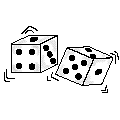1. Two coins are tossed and the number of heads is recorded.
Let X be a discrete random variable, where X is the number of heads.
a. Use the formula
for x = 1, 2, 3 to complete the table below.
(Remember that 0! = 1 and 1! = 1 and 2! = 2)
|
x
|
0
|
1
|
2
|
|
P(X = x)
|
b. Draw a vertical line graph to show this probability function.
2. The discrete random variable X has a probability distribution as follows:
|
x
|
3
|
4
|
5
|
6
|
7
|
|
P(X = x)
|
0.2
|
0.3
|
z
|
0.15
|
0.25
|
a. Find the value of z
b. Find P(4 ≤ X ≤ 6)
c. Find P(X < 5)
d. Draw a vertical line graph to show this distribution.
| 3. |
Draw probability distribution tables for the following experiments:
|
 |
4. The random variable Y has the following probability distribution:
|
y
|
2
|
4
|
6
|
8
|
|
P(Y = y)
|
3k
|
2k
|
k
|
4k
|
Find the value of k.
5. One of the values in this probability distribution table for the random variable Z is wrong.
|
z
|
10
|
11
|
12
|
13
|
|
P(Z = z)
|
0.2
|
0.3
|
1.1
|
0.4
|
a. Which value is wrong?
b. What should the correct value be?
6. The probability function for a discrete random variable W is shown below.
|
w
|
-2
|
-1
|
0
|
1
|
2
|
|
P(W = w)
|
0.25
|
0.1
|
0.2
|
0.3
|
0.15
|
If X = W2 show the probability distribution for the random variable X.
7. A wardrobe contains a drawer with 4 pairs of red socks and 6 pairs of green socks.
A pair of socks is taken out at random, and the colour noted and the socks are put back in the drawer. This is repeated 3 more times for a total of 4 pairs of socks.
Let Y be the random variable where Y = the number of red socks taken out of the drawer.
Draw a probability distribution table to show this.
8. The formula for a probability function is P(X = x) = kx for x = 4, 5 and 6
What is the value of k?